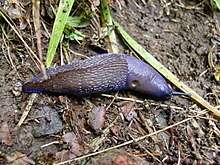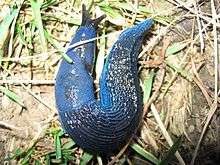Bielzia coerulans
Bielzia coerulans, commonly known as the Carpathian blue slug or simply the blue slug, is a species of very large land slug, a terrestrial pulmonate gastropod in the family Limacidae, the keelback slugs.
| Bielzia coerulans | |
|---|---|
 | |
| Bielzia coerulans | |
| Scientific classification | |
| Kingdom: | |
| Phylum: | |
| Class: | |
| (unranked): | clade Heterobranchia clade Euthyneura clade Panpulmonata clade Eupulmonata clade Stylommatophora informal group Sigmurethra clade limacoid clade |
| Superfamily: | |
| Family: | |
| Subfamily: | |
| Genus: | Bielzia |
| Species: | B. coerulans |
| Binomial name | |
| Bielzia coerulans M. Bielz, 1851[2] | |
| Synonyms[3] | |
| |
Taxonomy
Bielzia coerulans was discovered in 1847 and described under the name Limax coerulans by Austrian-Hungarian malacologist, Michael Bielz (1787-1866), in 1851. (His son Eduard Albert Bielz was also a malacologist.)
Bielzia coerulans is the only species in the genus Bielzia.[4]
Some authors, for example Russian malacologists,[3] classify genus Bielzia as the only genus (monotypic) within the separate family, Limacopsidae.[3][5] There is also a separate subfamily, Bielziinae, for genus Bielzia (I. M. Likharev & Wiktor, 1980).
According to the taxonomy of Bouchet & Rocroi (2005), Limacopsidae and Bielziinae are synonyms for Limacinae.[6]
Distribution
This species is endemic to the Carpathian Mountains in Eastern Europe.
The type locality of Bielzia coerulans is South Carpathians in Romania.[3]
- Czech Republic - in Moravia only, vulnerable (VU) in Moravia[7][8]
- Southern Poland[4]
- Slovakia[9]
- Ukraine[3]
- Romania[3]
- Hungary
- Turkey (Kaçkar Mountains, Rize Province)[10]
- Germany (presumed introduction in Westerwald, Rhineland-Palatinate, discovered 2012)[11]


Description
This slug turns blue when an adult and becomes 100 – 140 mm in length.[12] It is evenly blue or bluish green (occasionally black) with a dark greyish head and tentacles, and margins pale yellowish, sole pale yellowish or whitish.[12]
Juveniles are yellowish brown with dark lateral bands.[12]
Reproductive system: Genitalia are without penis.[12] There is only an accessory organ for copulation.[12]
Ecology
Bielzia coerulans inhabits deciduous and coniferous forests in mountains, usually at the bottom, or under dead wood logs.[12]
Maturity is in June to July.[12] Copulation occurs at the soil.[12] There are 30-80 eggs laid in one clutch.[12] Adults die after egg deposition.[12] Half grown juveniles hibernate.[12] Fully grown slugs appear in May.[12]
References
This article incorporates public domain text from the reference.[12]
- (in German) Clessin S. (1887). "Die Molluskenfauna Österreich-Ungarns und der Schweiz". pp. 1-858. Nürnberg. (Bauer & Raspe). page 47.
- (in German) Bielz M. (1851). "Verzeichniss der Land- und Süsswasser-Mollusken Siebenbürgens". Verhandlungen und Mittheilungen des Siebenbürgischen Vereins für Naturwissenschaften in Hermannstadt 2: 14-16, 55-59, 62-65. (Limax coerulans is on the page 14.)
- Kantor Yu I., Vinarski M. V., Schileyko A. A. & Sysoev A. V.(published online on December 22, 2009). "Catalogue of the continental mollusks of Russia and adjacent territories". Version 2.3.
- (in Polish) Wiktor A. (1989). Limacoidea et Zonitoidea nuda. Slimaki pomrowioksztaltne (Gastropoda: Stylommatophora). Fauna Poloniae 12, Polska Akademia Nauk, Warszawa, 208 pp., page 178-181.
- (in German) Gerhardt U. (16 July 1935). "Weitere Untersuchungen zur Kopulation der Nacktschnecken". Zeitschrift für Morphologie und Ökologie der Tiere 30(2): 297-332. Page 329.
- Bouchet, Philippe; Rocroi, Jean-Pierre; Frýda, Jiri; Hausdorf, Bernard; Ponder, Winston; Valdés, Ángel & Warén, Anders (2005). "Classification and nomenclator of gastropod families". Malacologia. Hackenheim, Germany: ConchBooks. 47 (1–2): 1–397. ISBN 3-925919-72-4. ISSN 0076-2997.
- Juřičková L., Horsák M. & Beran L. (2001). "Check-list of the molluscs (Mollusca) of the Czech Republic". Acta Soc. Zool. Bohem. 65: 25-40.
- "Red List of the molluscs (Mollusca) of the Czech Republic". accessed 9 September 2010.
- Lisický M. J. (1991). Mollusca Slovenska. Veda, Bratislava: 1-341.
- "Archived copy". Archived from the original on 2014-07-30. Retrieved 2014-07-28.CS1 maint: archived copy as title (link)
- Wiese, V.; Glasow, M. von D. (2013). "Blauschnegel Bielzia coerulans (M. Bielz 1851) in Deutschland (Gastropoda: Limacidae)" (PDF). Mitteilungen der Deutschen Malakozoologischen Gesellschaft. 89: 43–46. Archived from the original (PDF) on 2014-11-29. Retrieved 2014-11-21.
- "Species summary for Bielzia coerulans". AnimalBase, last modified 29 October 2009, accessed 9 September 2010.
External links
| Wikimedia Commons has media related to Bielzia coerulans. |